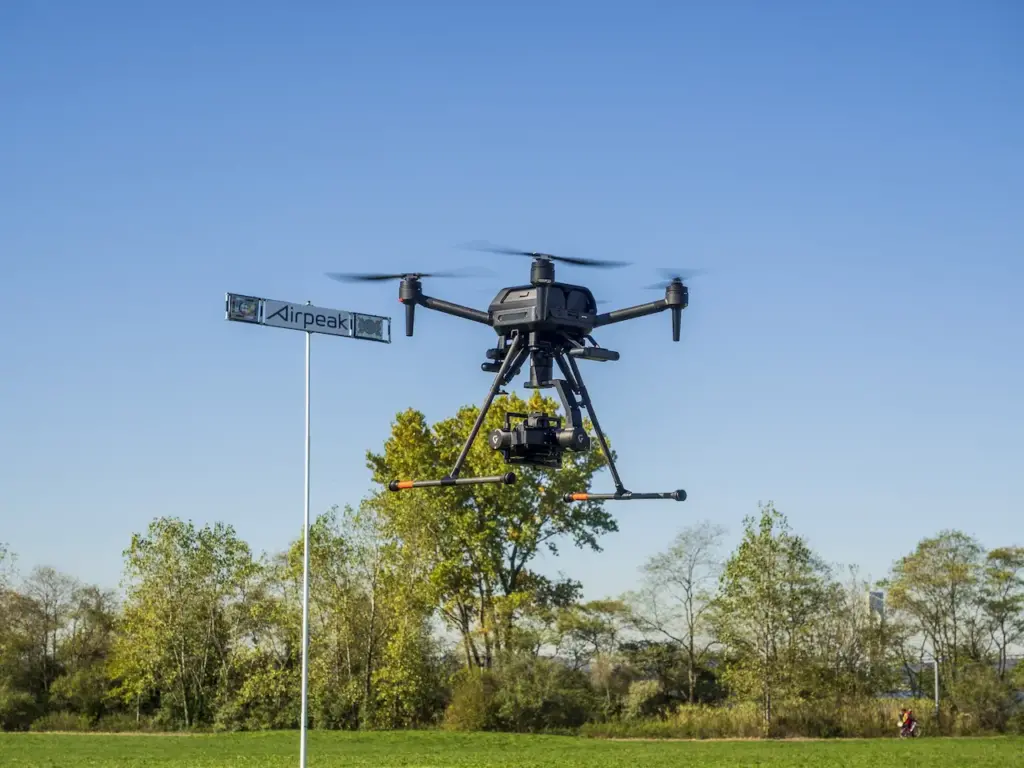There’s tons to unpack about the new Sony Airpeak S1 drone. The camera specs are unreal and should be highly appealing to the professional video market. The drone’s purported flight capabilities are equally as impressive. But your bank account likely won’t be impressed, as the Sony Airpeak S1 price tag is hefty.

The camera
Coming from Sony, it’s not surprising that the drone is especially notable for being able to carry many of Sony’s high-quality cameras. The S1 is the world’s smallest drone that can be equipped with a full-size mirrorless interchangeable-lens Alpha camera.
There’s not just one camera that comes with the drone. Instead, you’ll have extreme flexibility with this drone, and you’ll be able to choose the Sony camera that bet fits your requirements. The Airpeak S1 is compatible with a wide range of camera bodies. Here are some of the compatible cameras, and what they’re best suited for:
- The Alpha 7S series and FX3 for high descriptive capability with suppressed noise
- The Alpha 7R series for ultra-high definition
- The Alpha 9 series for distortion-free images
- The Alpha 1 for shooting footage in 8K
The Sony Airpeak S1 in flight
The S1 was built with a proprietary motor, propeller, control system and sensing technology.
It can reach maximum speeds of 55mph. And, it’s stable in relatively rough weather, with wind resistance in strong wind speeds up to 44.7mph. Here’s a pretty neat video of the drone undergoing a real wind resistance test at the Japan Aerospace Exploration Agency.
Much of that can be attributed to the drone’s lightweight, efficient, sturdy and responsive proprietary 17″ propeller and brushless motor, and is equipped with an ESC (Electric Speed Controller).
The Sony Airpeak also has taken extra measures to improve stability in flight, thanks to five Sony image sensors located on the front, back, left, right, and bottom of the drone. Those five sensors can enable obstacle braking, and can tell the drone to automatically decelerate and stop flying ahead, if necessary.
Sony’s Vision Sensing Processor is able to process camera data at high speeds and with low power consumption via proprietary algorithms that can estimate the aircraft’s spatial position and orientation in real time. Theoretically, that will enable stable flight even in environments where GNSS (Global Navigation Satellite System) reception may be hindered, such as indoors or under bridges.
The controller
Much of the Airpeak S1’s performance in the air can be attributed to its advanced remote controller, which is able to provide obstacle detection and automatic flight control via sensing.
The Airpeak S1 can integrate all sensor information such as IMU (Inertial Measurement Unit), direction, barometric pressure and infrared ranging. The drone also promises increased safety via cloud management of the aircraft and flight information.
The drone also integrates with software called “Airpeak Flight,” which is an applicatin compatible with most Apple devices that integrates the aircraft, transmitter, camera, and gimbal, allowing the operator to monitor status information such as flight distance and remaining battery power, and change various operations and settings on the screen.
There’s also a dual operation mode so that one user can operate the drone, while another user can operate the gimbal and camera simultaneously. That’s helpful for capturing cinematic shots, or just for better supporting your visual observer.
Software for enterprise applications
The drone integrates with a web application called “Airpeak Base” designed to help pilots manage equipment through an automatic list that can check the condition of the aircraft to minimize on-set equipment and provide necessary notifications. It can also help pilots create advanced flight plans and automatically fly the aircraft along the same course repeatedly. That could be helpful for filmmakers needing to replicate shots, allowing them to set the position (latitude, longitude and altitude) and speed of the aircraft along the timeline, and specify the orientation of the gimbal and the timing of video or still image shooting.
It also allows automatic flight log creation, which are then uploaded to the cloud via the mobile app Airpeak Flight. Past flight logs can be viewed on the logbook screen, and details such as in-flight errors can also be reviewed.
What to know about the Sony Airpeak drone line
Don’t expect this to be the only drone from Sony. While this is the Japanese camera maker’s first-ever professional drone, it likely won’t be it’s last. Sony is calling the S1 “an introductory model in the new Airpeak line.”
But intro doesn’t mean cheap. The drone will cost roughly US$9,000, including spare propellers, the remote controller, two batteries and a charger. If you want a gimbal (made by a third-party) that will cost extra, with pricing to be announced. And that US$9,000 doesn’t even include the camera bodies and their lenses, which you’ll have to buy separately.
The S1 is expected to ship this fall, but is already available for pre-order.
That said, this isn’t the only drone designed to carry Sony cameras. American drone company Skyfish is most famous for its Skyfish M4 and Skyfish M6 drones, both of which can fully integrate with the Sony Alpha series of cameras.
The post New details emerge on Sony Airpeak S1 drone — including an eye-popping price tag appeared first on The Drone Girl.







